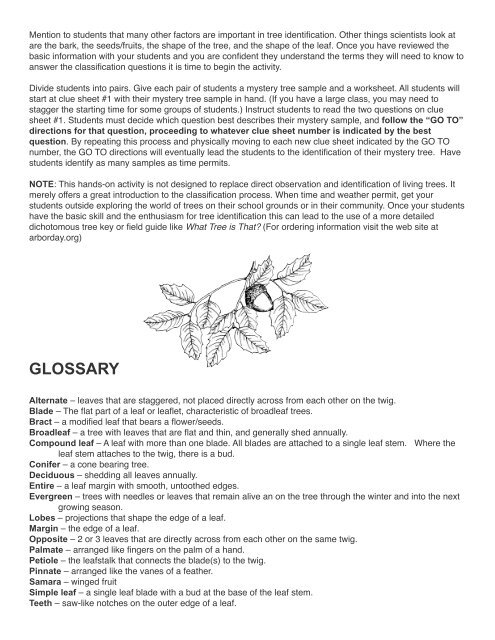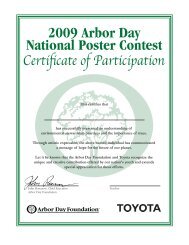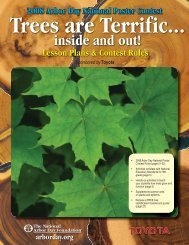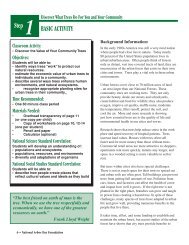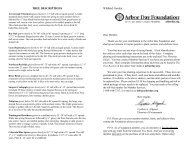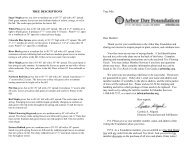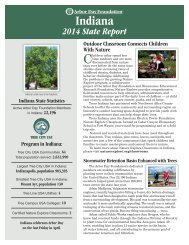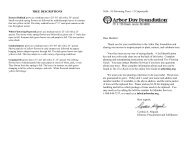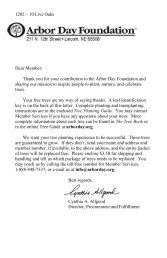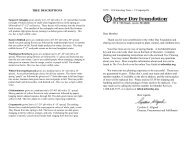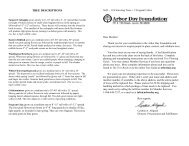Mystery Tree Challenge - Arbor Day Foundation
Mystery Tree Challenge - Arbor Day Foundation
Mystery Tree Challenge - Arbor Day Foundation
Create successful ePaper yourself
Turn your PDF publications into a flip-book with our unique Google optimized e-Paper software.
Mention to students that many other factors are important in tree identification. Other things scientists look at<br />
are the bark, the seeds/fruits, the shape of the tree, and the shape of the leaf. Once you have reviewed the<br />
basic information with your students and you are confident they understand the terms they will need to know to<br />
answer the classification questions it is time to begin the activity.<br />
Divide students into pairs. Give each pair of students a mystery tree sample and a worksheet. All students will<br />
start at clue sheet #1 with their mystery tree sample in hand. (If you have a large class, you may need to<br />
stagger the starting time for some groups of students.) Instruct students to read the two questions on clue<br />
sheet #1. Students must decide which question best describes their mystery sample, and follow the “GO TO”<br />
directions for that question, proceeding to whatever clue sheet number is indicated by the best<br />
question. By repeating this process and physically moving to each new clue sheet indicated by the GO TO<br />
number, the GO TO directions will eventually lead the students to the identification of their mystery tree. Have<br />
students identify as many samples as time permits.<br />
NOTE: This hands-on activity is not designed to replace direct observation and identification of living trees. It<br />
merely offers a great introduction to the classification process. When time and weather permit, get your<br />
students outside exploring the world of trees on their school grounds or in their community. Once your students<br />
have the basic skill and the enthusiasm for tree identification this can lead to the use of a more detailed<br />
dichotomous tree key or field guide like What <strong>Tree</strong> is That? (For ordering information visit the web site at<br />
arborday.org)<br />
GLOSSARY<br />
Alternate – leaves that are staggered, not placed directly across from each other on the twig.<br />
Blade – The flat part of a leaf or leaflet, characteristic of broadleaf trees.<br />
Bract – a modified leaf that bears a flower/seeds.<br />
Broadleaf – a tree with leaves that are flat and thin, and generally shed annually.<br />
Compound leaf – A leaf with more than one blade. All blades are attached to a single leaf stem. Where the<br />
leaf stem attaches to the twig, there is a bud.<br />
Conifer – a cone bearing tree.<br />
Deciduous – shedding all leaves annually.<br />
Entire – a leaf margin with smooth, untoothed edges.<br />
Evergreen – trees with needles or leaves that remain alive an on the tree through the winter and into the next<br />
growing season.<br />
Lobes – projections that shape the edge of a leaf.<br />
Margin – the edge of a leaf.<br />
Opposite – 2 or 3 leaves that are directly across from each other on the same twig.<br />
Palmate – arranged like fingers on the palm of a hand.<br />
Petiole – the leafstalk that connects the blade(s) to the twig.<br />
Pinnate – arranged like the vanes of a feather.<br />
Samara – winged fruit<br />
Simple leaf – a single leaf blade with a bud at the base of the leaf stem.<br />
Teeth – saw-like notches on the outer edge of a leaf.


